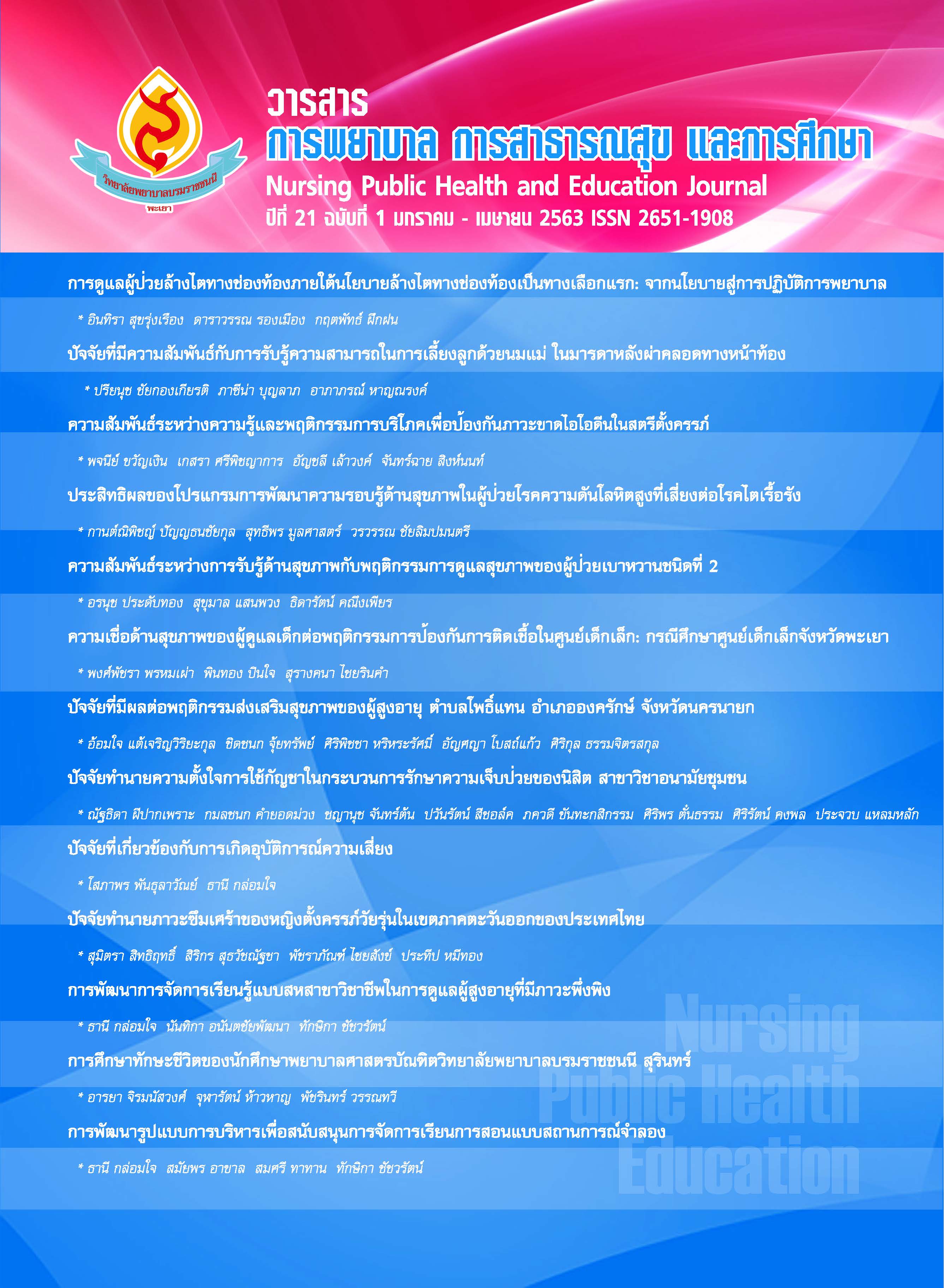ความเชื่อด้านสุขภาพของผู้ดูแลเด็กต่อพฤติกรรมการป้องกัน การติดเชื้อในศูนย์เด็กเล็ก: กรณีศึกษาศูนย์เด็กเล็กจังหวัดพะเยา
คำสำคัญ:
ความเชื่อด้านสุขภาพ, พฤติกรรมการป้องกันการติดเชื้อ, ผู้ดูแลเด็กบทคัดย่อ
การวิจัยเชิงพรรณนาหาความสัมพันธ์นี้มีวัตถุประสงค์เพื่อศึกษาความเชื่อด้านสุขภาพและพฤติกรรมการป้องกันการติดเชื้อของผู้ดูแลเด็ก และอธิบายความสัมพันธ์ระหว่างความเชื่อด้านสุขภาพกับพฤติกรรมการป้องกันการติดเชื้อของผู้ดูแลเด็กในศูนย์เด็กเล็ก กลุ่มตัวอย่างเป็นผู้ดูแลเด็กในศูนย์เด็กเล็กจังหวัดพะเยา จำนวน 197 คน ได้มาจากวิธีการสุ่มตัวอย่างแบบง่าย เครื่องมือที่ใช้ในการวิจัยประกอบด้วย แบบสอบถามข้อมูลส่วนบุคคล แบบสอบถามความเชื่อด้านสุขภาพของผู้ดูแลเด็ก ได้แก่ การรับรู้โอกาสเสี่ยงของการติดเชื้อ การรับรู้ความรุนแรงของการติดเชื้อ การรับรู้ประโยชน์ของการปฏิบัติ การรับรู้ต่ออุปสรรคของการปฏิบัติ การรับรู้ความสามารถของตน การได้รับข้อมูลข่าวสาร และแบบสอบถามพฤติกรรมการป้องกันการติดเชื้อในศูนย์เด็กเล็ก เก็บรวบรวมข้อมูลระหว่างเดือนตุลาคม ถึง ธันวาคม 2561 วิเคราะห์ข้อมูลด้วยสถิติพรรณนาและสถิติสหสัมพันธ์ของเพียร์สัน (Pearson’s product moment correlation)ผลการวิจัยพบว่าความเชื่อด้านสุขภาพโดยรวม อยู่ในระดับสูง ( = 3.13 S.D. = 0.18) โดยความเชื่อด้านสุขภาพด้านการรับรู้โอกาสเสี่ยงของการติดเชื้อ มีค่าคะแนนเฉลี่ยสูงสุด เท่ากับ 3.62 ส่วนการรับรู้ต่ออุปสรรคของการปฏิบัติ มีค่าคะแนนเฉลี่ยต่ำสุด เท่ากับ 1.95 โดยรวมผู้ดูแลเด็กในศูนย์เด็กเล็กมีพฤติกรรมการป้องกันการติดเชื้อในศูนย์เด็กเล็กระดับสูง (
= 3.74 S.D. = 0.28) และความสัมพันธ์ระหว่างความเชื่อด้านสุขภาพโดยรวมมีความสัมพันธ์ในทางบวกในระดับต่ำมากกับพฤติกรรมการป้องกันการติดเชื้อของผู้ดูแลเด็กในศูนย์เด็กเล็กที่ระดับนัยสำคัญทางสถิติ (r = .268, p < .001) เมื่อพิจารณารายด้าน พบว่า การรับรู้ความสามารถของตน และการได้รับรู้ข้อมูลข่าวสาร มีความสัมพันธ์ทางบวกกับพฤติกรรมป้องกันการติดเชื้อ (r = .452 และ .236 ตามลำดับ) อย่างมีนัยสำคัญทางสถิติที่ระดับ .001 ผลการศึกษานี้เสนอให้ควรนำผลการศึกษาไปพัฒนาจัดทำโปรแกรมการส่งเสริมพฤติกรรมการป้องกันการติดเชื้อในศูนย์เด็กเล็กสำหรับผู้ดูแลเด็กให้มีประสิทธิภาพยิ่งขึ้น รวมทั้งมีการศึกษาในเชิงคุณภาพเพื่อติดตามผลเป็นระยะ เพื่อให้เกิดพฤติกรรมการป้องกันการติดเชื้อที่ยั่งยืนต่อไป
เอกสารอ้างอิง
กรมอนามัย กระทรวงสาธารณสุข. (2554). แนวทางการป้องกันควบคุมโรคติดต่อในศูนย์เด็กเล็ก (สำหรับผู้ดูแลเด็ก). นนทบุรี: สำนักงานพระพุทธศาสนาแห่งชาติ.
เกศรา เสนงาม, แจ่มจันทร์ กุลวิจิตร, และลัคณา คงแสง.(2555). ภาวะสุขภาพและปัจจัยที่มีความสัมพันธ์กับ ภาวะสุขภาพของเด็กปฐมวัยที่รับบริการที่ฝ่ายพัฒนาเด็กปฐมวัย.วารสารพยาบาลสงขลานครินทร์, 32(1), 11-26.
จักรพงศ์ เอี้ยวตระกูล และคณะ. (2555). ความรู้และการปฏิบัติในการควบคุมโรคมือเท้าปากของบุคลากรในสถานบริการเลี้ยงเด็ก เขตเทศบาลนครขอนแก่น. ศรีนครินทร์เวชสาร, 27(3), 250-257.
จารุวรรณ แหลมไธสง. (2559). ปัจจัยทำนายพฤติกรรมการป้องกันโรคติดเชื้อทางเดินหายใจของผู้ดูแลเด็กปฐมวัย ในศูนย์เด็กเล็ก กรุงเทพมหานคร. (วิทยานิพนธ์พยาบาลศาสตรมหาบัณฑิต สาขาวิชาการพยาบาลเวชปฏิบัติชุมชน), ชลบุรี. มหาวิทยาลัยบูรพา.
จุฬาลักษณ์ แก้วสุก, ยุนี พงศ์จตุรวิทย์ และนุจรี ไชยมงคล. (2558). ปัจจัยทำนายพฤติกรรมของมารดาในการป้องกันโรคติดเชื้อเฉียบพลันระบบหายใจในเด็กวัยก่อนเรียน. ใน การประชุมวิชาการและนำเสนอผลงานวิจัยระดับชาติและนานาชาติ ครั้งที่ 6 “ก้าวสู่การวิจัยระดับโลก”, วารสารบทคัดย่อกลุ่มวิทยาศาสตร์ และเทคโนโลยี.กรุงเทพฯ: มหาวิทยาลัยราชภัฏสวนสุนันทา.
ชญาน์นันท์ ใจดี, เสริมศรี สันตติ และชื่นฤดี คงศักดิ์ตระกูล. (2555). ปัจจัยที่มีความสัมพันธ์กับพฤติกรรมการ ป้องกันโรคติดเชื้อเฉียบพลันระบบหายใจของผู้ดูแลเด็กในสถานรับเลี้ยงเด็ก.รามาธิบดีพยาบาลสาร, 18(3), 389-403.
ณัฏฐวัส ประสมนาค. (2552). ปัจจัยที่มีความสัมพันธ์กับพฤติกรรมการป้องกันและควบคุมโรคติดเชื้อเฉียบพลันระบบหายใจในเด็ก 0-5 ปี ของผู้ดูแลเด็ก ในเขตรับผิดชอบของสถานีอนามัยนางาม ตำบลตาพระยา อำเภอตาพระยา จังหวัดสระแก้ว. สืบค้นเมื่อ 11 ธันวาคม 2562 จาก http://team.sko.moph.go.th
ประสพชัย พสุนนท์. (2557). การกำหนดขนาดตัวอย่างตามแนวทาง Krejcie and Morgan (1970) ในการวิจัยเชิงปริมาณ. วารสารวิชาการศิลปศาสตร์ประยุกต์, 7(2): 112-120.
ฤดีพร ผ่องสุภาพ. (2551).การแสวงหาข่าวสารการประชาสัมพันธ์และความพึงพอใจในการสื่อสาร ผ่านเครือข่ายสังคมออนไลน์ของนิสิตนักศึกษา. จุฬาลงกรณ์มหาวิทยาลัย/กรุงเทพฯ,: สำนักระบาดวิทยา กรมควบคุมโรค กระทรวงสาธารณสุข. (2550). รายงานการเฝ้าระวังทางระบาดวิทยาประจำสัปดาห์, สืบค้นเมื่อ 11 กรกฎาคม 2562 จาก http://www.boe.moph.go.th.
สำนักระบาดวิทยา กรมควบคุมโรค กระทรวงสาธารณสุข. (2554). รายงานการเฝ้าระวังทางระบาดวิทยาประจำ สัปดาห์. สืบค้นเมื่อ 11 กรกฎาคม 2562 จาก http://www.boe.moph.go.th.
สำนักระบาดวิทยา กรมควบคุมโรค กระทรวงสาธารณสุข. (2555). รายงานการเฝ้าระวังทางระบาดวิทยาประจำ สัปดาห์. สืบค้นเมื่อ 11 กรกฎาคม 2562 จาก http://www.boe.moph.go.th.
Becker, M. H. (1974). The health belief model and sick role behavior. In M.H. Becker(Ed.), The health belief model and personal health behavior. Thorofare, NJ: Charles B.Slack.
Best, J. W., & Kahn, J. V. (1993). Research in education. (7th ed). Englewood Clifts, NJ.: Prentice-Hall.
Fairchok, M.P., Martin, E.T., Chambers, S., Kuypers, J., Behrens, M., Braun, L.E., (2010). Epidemiology of viral respiratory tract infections in a prospective cohort of infants and toddlers attending day care.Journal of clinical virology, 49(1), 16-20.
Mink, C.M., &Yeh, S. (2009). Infections in child-care facilities and schools.Pediatrics in Review, 30(7), 259-269.
Sommer, C., Resh, B., &Simoes, A.F. (2011). Risk factors for severe respiratory syncytial virus lower respiratory tract infection. The Open Microbiology Journal, 5(2), 144-154.
Stretcher, V. J., &Rosenstock, I. M. (1997)The Health belief model. In K. Glanz, F. M. Lewis, & B. K. Rimer, (eds.), Halth behavior and health education: Theory, research, and practice. San Francisco: Jossey-Bass.
Sun, Y., & Sundell, J. (2011). Early day care attendance increase the risk for respiratory infections and asthma of children. Journal of ฤsthma, 48(8), 790-796.
ดาวน์โหลด
เผยแพร่แล้ว
รูปแบบการอ้างอิง
ฉบับ
ประเภทบทความ
สัญญาอนุญาต
ลิขสิทธิ์ (c) 2020 วารสารการพยายาล การสาธารณสุข และการศึกษา

อนุญาตภายใต้เงื่อนไข Creative Commons Attribution-NonCommercial-NoDerivatives 4.0 International License.



